Automatic Fedorov. Weapons that could shake the world
Outstanding Russian gunsmith, gun expert and historian weapons V. G. Fedorov rightly entered into history domestic small arms as the “father of automatic weapons”. He was the author of the first theoretical work “Automatic weapons” (1907 year) with the application “Atlas of drawings with automatic weapons”, which for a long time remained the only research in this area. He owns the first Russian automatic rifle and the first-ever assault rifle adopted by the Russian army. He owns the classification of automatic infantry weapons on:
Self-loading rifles, shooting single shots and having a magazine with a capacity of 5-10 cartridges.
Self-rifle rifles, structurally similar to self-loading, but allowing to fire in a queue before emptying the store.
Automatic. Weapons are similar to self-rifle rifles, but having an add-on magazine with an 25 capacity of ammunition ... a shortened barrel with a handle that makes the weapon suitable for a wide range of combat missions.
Russia very early began work on the creation of automatic rifles, not yielding to the leading military-industrial powers of the time. Researches were conducted by Ya. U. Roschepey, P. N. Frolov, F. V. Tokarev, V. A. Degtyarev and other enthusiasts - inventors. All work was carried out on the authors' bare enthusiasm, without financial, theoretical and organizational support from the state. Ya. U. Roshchepey was forced to sign a declaration stating that, with his success, he “will be satisfied with a one-time bonus and will no longer claim anything.” So it is not surprising that not one of these nuggets (Tokarev and Degtyarev, famous gunsmiths of the future) could bring their samples to at least military trials. Only V. G. Fedorov managed this. Russian gunsmith VG Fedorov began work on the remaking of the magazine rifle sample 1891g. in automatic with 1905 of the year. To help Fedorov, the head of the shooting range of the officer rifle school N. M. Filatov appointed a mechanic V. A. Degtyarev. The conversion of the magazine rifle into an automatic one was recognized as inexpedient and in 1906 a fundamentally new project was ready, which was notable for simplicity and expediency (54 details instead of 74 in Browning). The rifle of the original design for a regular cartridge successfully passed all military tests in 1909-1912. The tests were cruel: they left the weapons for a day in the rain, put them into disassembled form in a pond, drove them on a cart on a dusty road, and then checked them by shooting. For this rifle, Fedorov was awarded a large Mikhailov Prize (Gold Medal), issued once in 5 years (S. I. Mosin was also awarded this prize). The Sestroretsk plant was ordered 150 pieces of new rifles.
The Russo-Japanese War intensified interest in light automatic infantry weapons: the Madsen light machine gun, adopted by the Russian cavalry, turned out to be a formidable type of weapon. A designer seriously interested in the technology used in small arms of the Japanese army. Recall that Japan, and a considerable number of other countries - Greece, Norway, Italy, Sweden, Romania were armed with a reduced rifle - 6.5 mm caliber. The tradition of reducing caliber, which began in the last quarter of the 19 of the 20th century, was obvious: the remake (converted from a rifled muzzle-loading rifle) Krnka rifle (or Krynka in the common folk) had a caliber of 6 lines (15.24mm); the rifle of Berdan №2 (actually Gorlov and Gunius, Berdan had nothing to do with it :)) already 4 lines, and the creation of Mosin had three caliber already — that is 7,62 mm. Each caliber reduction reflected a growing level of barrel processing technology and the mass production of precision ammunition. Some designers decided to go further. And it seemed fashionable: the ammunition wearable by the shooter increased, the recoil decreased when fired, the metal consumption decreased in the production of ammunition.
Fedorov automatic rifle
The officers' responses stated that “there was no difference between the fire of the Russian and Japanese rifles with the exception of close combat”. Since they preferred to rely on hand grenades, bayonets and revolvers in close combat, the problem of the smaller stopping effect of a small-caliber bullet did not worry anyone yet. It should be noted that the decrease in metal intensity was to a certain extent offset by increased costs due to defects and tighter tolerances in manufacturing.
In 1913, Fedorov proposed his own 6.5 cartridge, mm of improved ballistics, which does not have a welt (cap for extracting from the chamber of an extractor) and a new light automatic rifle for it. This automatic rifle was very close to its predecessor –7.62, differing in a five-round staggy magazine that does not protrude beyond the weapons. The rifle was tested successfully, and an order for 20 automatic rifles 6.5mm was issued to the Sestroretsky plant, but the First World War began, forcing the work to be interrupted, and Fedorov himself sent “In Search of Weapons” abroad ...
Radically changed tactics of infantry combat. The long-barreled rifle, with its sniper accuracy, has lost its meaning very much. The salvo firing at the platoon in invisible to the naked eye targets was completely gone, giving way to the field of field artillery and heavy machine guns. Lost value bayonet. The “chest on chest” contractions degenerated into slaughter in trenches, where it was thicker and more likely to fire, sharper and sharper. Moreover, the infantry assembled for a bayonet attack into a dense formation was simply doomed to be killed by the enemy’s arrows and artillery. There were teeth in new types of weapons: at medium distances, various bomb-bombs (mortars) and machine guns, manual and mounted, were more successful. With the enemy burst into the trenches, they fired from revolvers and slashed with deminers; well established themselves fragmentation grenades. The popularity of the short-barreled brat of a rifle - a carbine (it is shorter and more maneuverable). The war interrupted or delayed the work on automatic weapons in all countries.
Automatic Fedorov
Germany: at the end of the first world, the Mauser automatic rifle was not used, it was not suitable for full armament of infantry (sensitivity to dirt and abundant lubrication of cartridges for the stable operation of automation).
England: there was no precedent.
France: Riberol-Shoch-Stattar automatic rifle was tested in the army from 1916, and in 1917 it was accepted for partial armament of infantry.
USA: The mass of the Browning rifle was recognized as over-dimensional and an automatic rifle with a magazine of increased capacity was positioned as a light machine gun.
In 1916, Fedorov made his brilliant discovery: he invented the automaton. Shortening the barrel on his 1913 model rifle and supplying it with a removable 25 magazine box magazine and a firing handle “from hand”, he received the first weapon model that has now become the basis of infantry weapons of any army. It remains only to marvel at the accuracy of the conclusions made by the Russian gunsmith: not an automatic rifle with its weight, long barrel, crushing dedication and sluggishness when meeting face to face; not a pistol - a machine gun with its helplessness when firing at medium and long distances - namely, an automatic - a short-barreled weapon with a direct shot range of about 300 meters, a mass of about 5 kg and a rate of about 100 shots per minute - that is, what is called in Russian precisely automatic. The First World War is over; Civil; and only in 1943, Hugo Schmeisser will reveal to the world (of course, already as the fruit of the technical thought of enlightened Europe) his assault rifle under a shortened rifle cartridge with close tactical and technical characteristics ... And experts will argue whether M. Kalashnikov’s work was with him kinship - or did not consist? (Interesting, but for some reason nobody intrigues the question of the M16 and STG-44 affinity!) And the veterans of the 11 Army who passed the assault on Koenigsberg will note that the weapon was convenient, very lethal, and this trophy was used willingly. Nevertheless, the birthplace of the automaton is Russia.
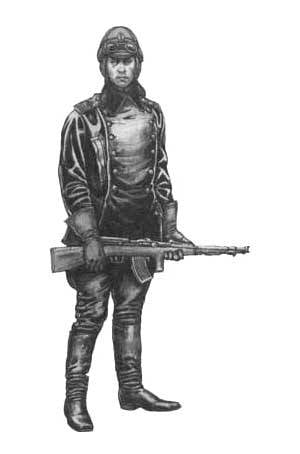
Russian scooter armed with an automatic machine Fedorov
Fedorov machine in battle
The career of this wonderful weapon has developed poorly. In the summer of 1916, Fedorov's submachine guns and automatic rifles were armed with the command of the 189th Izmail Regiment, which was sent to the Romanian front on December 1 of the same year, consisting of 158 soldiers and 4 officers. They became the first Russian machine gunners. Fedorov's assault rifles were sent to the 10th Air Division. They were 400 grams lighter than Fedorov's 7.62 mm rifles and allowed intense burst fire. Since there was nothing to dream about the production of an author's cartridge in wartime, the weapon was converted to firing a cartridge of the Japanese rifle Arisaka arr. 1895 6.5mm. Russia, finding itself in a state of industrial collapse, was buying up arms around the world. Among other samples, Japanese weapons occupied a considerable place (782 thousand). The Japanese cartridge was shorter and weaker than the author's, which made it even closer to the intermediate one, but the rim left by the designers (the cartridge has both an annular groove and a rim - but of a smaller diameter than usual) still made it less successful for automatic operation. The assault rifle received excellent reviews: high reliability, strength of the bolt-locking parts, good accuracy of fire - and at the same time they saw in it only a light, but still a machine gun. Soon after the October Revolution (or government coup) Fedorov was sent to Kovrov to continue work on the production of machine guns. It was 1918. At the plant he was elected director (then this position was elective!). Degtyarev was appointed head of the experimental workshop. The next year the machines were put into mass production. In 1924, the collective began to create a number of machine guns unified with a machine gun - manual, aviation, anti-aircraft, tank. Historians and sources are silent about the participation of the Fedorov assault rifle in the civil war. The only mention of units where this weapon was used, I found (a paradox!) In M. Bulgakov. In the novel “Fatal Eggs,” the OGPU operative Polaitis had an “ordinary 25-round machine gun” - the term “machine gun” never came out of academia. The type of use of the ammunition remains a mystery - either the cartridge of the Arisaka rifle, or the author's ammunition. However, until the beginning of the 30s, the Red Army was armed with light machine guns from many countries. Two tank Fedorov machine guns were installed in the tower of the MS-1 tank, and it was in this form that he took part in the conflict at the Chinese Eastern Railway. - This was the last battle of this wonderful weapon. People's Commissar of Armaments L. Vannikov noted in the "notes of the People's Commissar" that Fedorov's assault rifle often lay on Stalin's desk; but it had no consequences for the machine. In the early 30s, he will not like the "responsible comrades" from the Kremlin and will be removed from service. The reasons? There are no compelling reasons: from the use of an imported cartridge (was it imported; what prevented the establishment of its production?) To the presentation of fantastic requirements for the ability to hit armored targets (however, we will: after the Finnish, they adopted a completely grotesque mortar shovel) ...
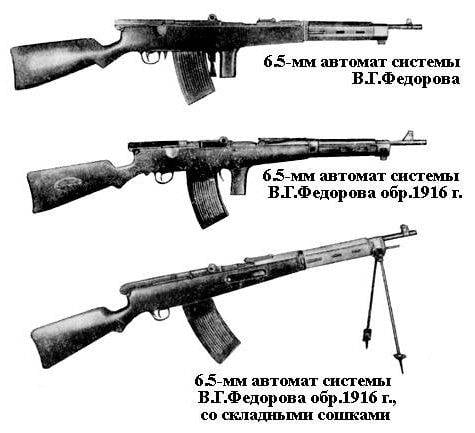
Figure - Automatic Fedorov
Caliber - 6.5mm, special or Japanese cartridge. Automatics with a short stroke of the rolling barrel. The bolt is locked by two larvae, the trigger hammer mechanism provides for firing bursts and single shots. The shop is very rationally made - 25 of cartridges with a chess arrangement of them. In the early versions, the rifle sight, in the later versions - sector, similar to the AKM sight. The range of the direct shot is estimated as 300-400 meters.
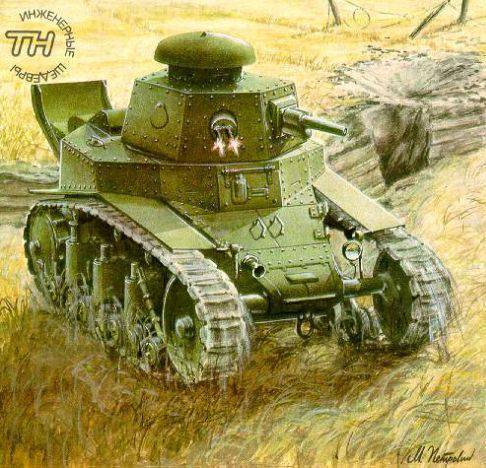
The figure shows an early version of the MC-1 tank with Fedorov machine guns. Later they will be replaced by a single machine gun DT DT 7.62mm. Machine-driven Ammunition will decrease by 25%. The density of machine-gun fire will also decrease: in the ball installation, instead of two trunks, it was now standing alone.
| System name and country | Caliber, mm | Length, mm | Barrel length, mm | Operating principle | Curb weight, kg | Capacity of the store, pieces | Rate of fire, shots / min. | Sighting range, m |
|---|---|---|---|---|---|---|---|---|
| Fedorov, 1916. Russia, USSR | 6.5 | 1045 | 520 | Trunk recoil | 4.4 + 0.8 (automatic and store) | 25 | ---- | 2100 |
| AK-47,1947. the USSR | 7.62 | 870 | 414 | Removal of gases from the barrel | 3.8 | 30 | 600 | 800 |
| STG-44, Germany, 1944. | 7.92 | 940 | 419 | Removal of gases from the barrel | 5.2 | 30 | ---- | 800 |
1Note: There is a discrepancy. B.N. Spavrochnik The Beetle describes the Arisaki cartridge as having a welt and an annular groove. The book of the Mavrodins and the journal “Science and Life” indicate that the welt cartridge did not have, moreover, was special.
Used Books:
Vlad V. Mavrodin, Val. Vlad Mavrodin “From the history of domestic weapons. Russian rifle.
B. N. Zhuk “Automatic rifles and guns”.
“Science and Life” №5 1984, article “Small arms” A. Volgin.
“Technique and Science” №2 1984, to be “One of the First” A. Beskurnikov.
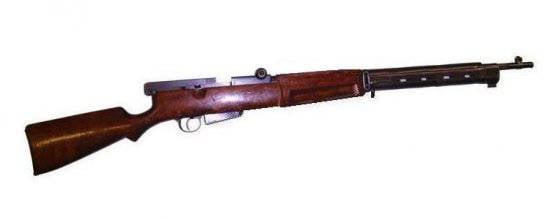
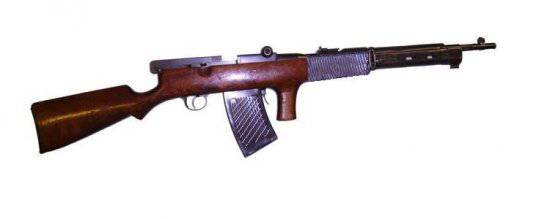
Information